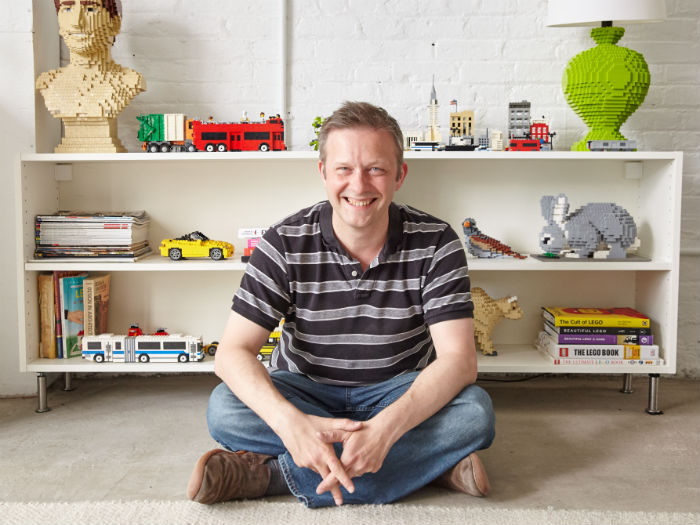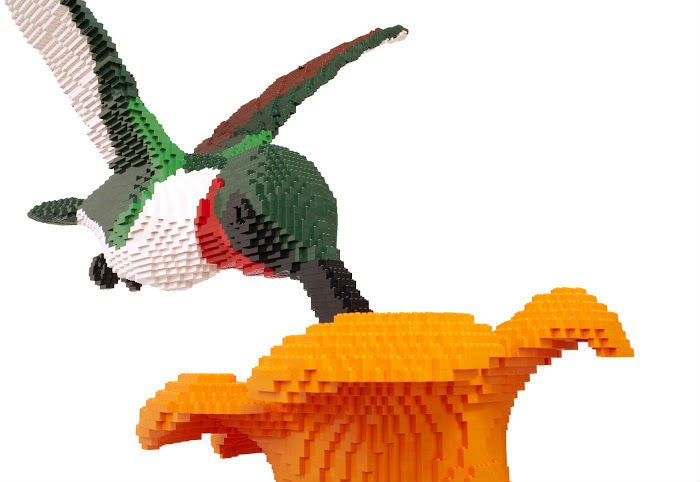LEGOs® at the MAC: Q&A with Nature Connects artist Sean Kenney
Posted on November 19, 2015 at 6:00 am
By Alison Highberger
Guest Writer

Image courtesy of Sean Kenney
The Northwest Museum of Arts & Culture’s new exhibit, Nature Connects: LEGO® Brick Sculptures, features 27 flora- and fauna-inspired works of art by New York City artist Sean Kenney. Made of nearly 500,000 LEGO pieces, the exhibit includes a 4-foot-long bee, a 7-foot-tall rose, an 8-foot-tall hummingbird, and a life-size bison and calf.
The exhibit, which runs now through February 7, 2016, also has about 200 local LEGO contest entries on display, created by kindergarteners through adults from the Inland Northwest. Museum visitors can vote on their favorite local LEGO sculptures until December 19, and winners in every age category will be announced on December 20. The “Best of Show” winner will receive a $500 gift certificate and his or her choice of one of the giant LEGO figures that currently adorn the outside of the museum!
We know if you go to the exhibit, you’ll be curious about the artist who created the beautiful and complex LEGO sculptures. Sean Kenney, 39, is a world-renowned artist who uses millions of LEGO pieces to design and create contemporary sculptures for high profile clients, major corporations, and venues around the world. At his studio in Brooklyn, Sean has a small team of assistants who help with the design and building of his sculptures. His award-winning, record-breaking shows feature everything from architecture to insects, plants, animals, and the human form. Sean has also authored 7 best-selling LEGO-themed children’s books. He’s married and has a 4-year-old daughter and a 6-month-old son.
Sean recently shared answers to some frequently asked questions about his career and art with us. Read on to find out more about this fascinating artist!
When and how did you become interested in LEGOs?
I’ve been building and playing with LEGO toys my whole life. I was a total “LEGO maniac” when I was a kid, and LEGOs were usually the only toys I ever asked for when my birthday would come around each year. I kept building LEGO models all through childhood and even into my teenage and adult years. My models became more involved and elaborate as I got older, and eventually I started building LEGO models professionally. Now, it’s my full-time career.
What was the inspiration that made you go from LEGO enthusiast to full-fledged artist and creator?
Before I became a LEGO professional, I worked as a cartoonist, a graphic artist, and a website designer. I spent 10 years designing website interfaces and web user experiences, and I wore a suit every day to work. But the whole time, my “inner child” was itching to get out and play! Every night after work I would go home and play with my LEGO toys, sometimes while I was still in my suit!
One day I was sitting in my office in a cold-looking, boring 40-story skyscraper on Park Avenue in New York City. I was sitting at my desk, but I wasn’t working; I was daydreaming about beautiful architecture and bright LEGO colors, and thinking about what I would build with my LEGO bricks when I got home. It was about then when I realized that was exactly what I needed to do. I should follow my dreams. So I stood up, took off my tie, and walked straight out—just like that, in the middle of the day, and I never looked back.
How big is your LEGO collection?
I currently have over 3.5 million LEGO bricks in my studio. It’s hard to say how many models I’ve built—certainly hundreds, maybe even thousands, throughout my whole life. In any given year, I might create a dozen or so commissioned pieces, a few dozen small, gift-sized models, and lots of sculptural pieces simply for my own edification. When creating models for my books, I make hundreds more than are ever eventually published. I go through about 250,000 to 400,000 LEGO pieces every year.

Image courtesy of Sean Kenney
What is the process you go through to create your sculptures?
Each sculpture can have a different process. For example, the design of the hummingbird sculpture in my Nature Connects show just popped in my head the minute someone said “hummingbird.” I immediately had this vision of something that you could actually walk under, suspended as if by magic. Creating a spindly little nose and paper-thin wings built out of chunky LEGO pieces seemed like a wonderful challenge and, if done right, something that would look amazing. I spent about 4 weeks designing and planning this specific piece, researching images of hummingbirds in nature, choosing the perfect colors, and designed the internal steel reinforcements, and then about 5+ weeks building it.
I don’t use computers to plan out my sculptures. It’s far too complex and, if you ask me, it takes a lot of the fun out of it! When I’m designing a model, I gather as many photographs or drawings of the subject as I can, then use graph paper to plan out the basic shape and size. After that, I start building a prototype using my graphed plans as a guide. There’s a lot of visualization required, and often I have to step back and examine the model from all sides as it’s coming together, often taking sections apart and rebuilding them! Once I have a prototype that I like, I’ll rebuild it, glued, using the prototype as a template.
Depending on the size of the sculpture, it can take anywhere from a few days to weeks or even months to build. And if the model is something that needs to be uniquely recognized, I spend a lot more time making sure it’s perfect. For example, a life-size human head (of no one in particular) can take about a day to prototype, but if the head is a model of a specific person, it can take 3 days.
What inspired you to create the “Nature Connects” show?
The show was developed in conjunction with Iowa State University’s Reiman Gardens in 2011 and has been on tour since early 2012. Fundamentally, the show is about connections. Much as LEGO pieces connect, everything in nature is connected with an intricate balance. It is important to me that each individual sculpture attempt to illustrate some of the “connections” found in nature, whether it’s a fox hunting a rabbit, a hummingbird feeding on a trumpet flower, or others that just showcase the beauty of nature, like a giant rose. There’s also a life-size lawn mower that visitors often mistake for the real thing, which is good for a laugh, but also shows humankind’s connection to nature.
What have been some of your more challenging pieces to create?
The most challenging thing is to create curved shapes with those hard, little plastic rectangles. Making something round and curvy like a shoe or a ball can be tricky, but the most complex thing is to create people’s faces.
What one LEGO piece can’t you do without when creating one of your masterpieces?
The basic rectangles are all you really need. If all I had was a giant pile of 2×4 bricks, I could create anything.
What advice do you have for someone who wants to pursue the LEGO arts?
Art has to come from within, so do what you are passionate about. I didn’t wake up one morning building 50,000 piece sculptures; I’ve learned everything by simply building over and over all my life. Keep building, and don’t grow up! Share your creations online for tips and feedback and, of course, practice makes perfect.
For more information about the Nature Connects exhibit, please visit www.northwestmuseum.org.
Alison Highberger serves as the Media Relations Specialist for Northwest Museum of Arts & Culture.
